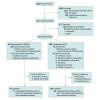Rehabilitation Transition Program to Improve Community Participation Among Stroke Survivors: A Randomized Clinical Trial
- PMID: 39374016
- PMCID: PMC11581659
- DOI: 10.1001/jamanetworkopen.2024.37758
Rehabilitation Transition Program to Improve Community Participation Among Stroke Survivors: A Randomized Clinical Trial
Abstract
Importance: Interventions are needed to support the long-term needs of stroke survivors when they transition from inpatient rehabilitation to home, where they face new home and community environmental barriers.
Objective: To compare the efficacy of a novel, enhanced rehabilitation transition program with attentional control to improve community participation and activity of daily living (ADL) performance and to reduce environmental barriers in the home and community after stroke.
Design, setting, and participants: This phase 2b, parallel randomized clinical trial assessed patients 50 years or older who had experienced an acute ischemic stroke or intracerebral hemorrhage, were independent in ADLs before stroke, and planned to be discharged home. Patients were assessed at an inpatient rehabilitation facility in St Louis, Missouri, and their homes from January 9, 2018, to December 20, 2023.
Intervention: Community Participation Transition after Stroke (COMPASS), including home modifications and strategy training.
Main outcomes and measures: The primary outcome was community participation (Reintegration to Normal Living Index). Secondary outcomes were daily activity performance (Stroke Impact Scale ADL domain and the In-Home Occupational Performance Evaluation [I-HOPE] activity, performance, and satisfaction scores) and environmental barriers in the home (I-HOPE environmental barriers score).
Results: A total of 185 participants (mean [SD] age, 66.3 [9.0] years; 105 [56.8%] male) were randomized (85 to the COMPASS group and 100 to the control group). The COMPASS and control participants experienced similar improvements in community participation by 12 months, with no significant group (mean difference, 0.3; 95% CI, -4.6 to 5.2; P = .91) or group × time interaction (between-group differences in changes over time, 1.3; 95% CI, -7.1 to 9.6; P = .76) effects. Improvements in I-HOPE performance and satisfaction scores were greater for COMPASS participants than control participants at 12 months (between-group differences in changes for performance: 0.39; 95% CI, 0.01-0.77; P = .046; satisfaction: 0.52; 95% CI, 0.08-0.96; P = .02). The COMPASS participants had greater improvements for I-HOPE environmental barriers than the control participants (P = .003 for interaction), with the largest differences at 6 months (between-group differences in changes: -15.3; 95% CI -24.4 to -6.2).
Conclusions and relevance: In this randomized clinical trial of stroke survivors, participants in both groups experienced improvements in community participation. COMPASS participants had greater improvements in self-rated performance and satisfaction with performing daily activities as well as a greater reduction in environmental barriers than control participants. COMPASS reduced environmental barriers and improved performance of daily activities for stroke survivors as they transitioned from inpatient rehabilitation to home.
Trial registration: ClinicalTrials.gov Identifier: NCT03485820.
Conflict of interest statement
Figures



References
-
- Tsao CW, Aday AW, Almarzooq ZI, et al. ; American Heart Association Council on Epidemiology and Prevention Statistics Committee and Stroke Statistics Subcommittee . Heart disease and stroke statistics-2023 update: a report from the American Heart Association. Circulation. 2023;147(8):e93-e621. doi:10.1161/CIR.0000000000001123 - DOI - PubMed
Publication types
MeSH terms
Associated data
Grants and funding
LinkOut - more resources
Full Text Sources
Medical

